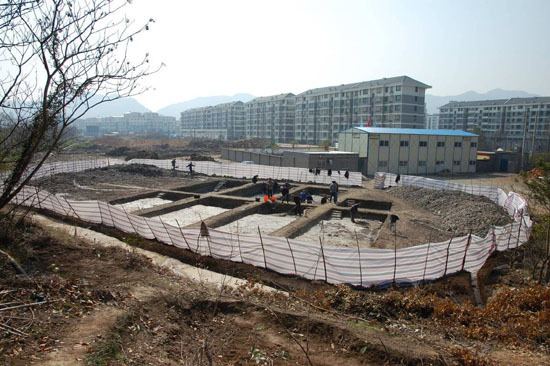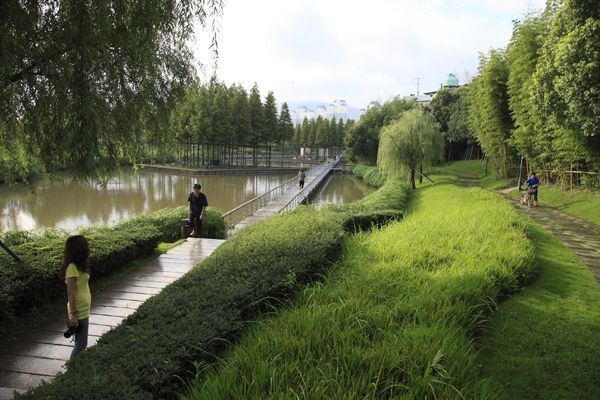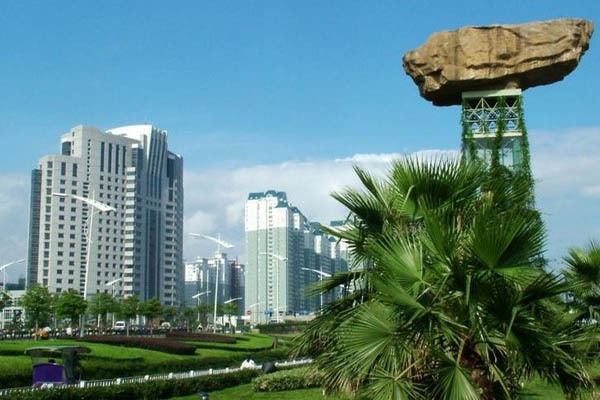Population 1.492 million (2000) Area 9,411 km2 | University Taizhou University Mayor Zhang Bing (? ?) | |
 | ||
Country Peoples Republic of China | ||
Map of Taizhou, Zhejiang
Taizhou ( [tʰái.ʈʂóu]), previously known as Taichow, is a city on the eastern coast of China's Zhejiang province, facing the East China Sea. It is located 300 km (190 mi) south of Shanghai and 230 km (140 mi) southeast of Hangzhou, the provincial capital. It is bordered by Ningbo to the north, Wenzhou to the south, and Shaoxing, Jinhua, and Lishui to west. In addition to the municipality itself, the prefecture-level city of Taizhou includes 3 districts, 2 county-level cities, and 4 counties. At the 2010 census, its population was 5,968,838 inhabitants whom 3,269,304 lived in the built-up (or metro) area made of 3 urban Districts and Wenling City now being largely conurbated.
Contents
- Map of Taizhou Zhejiang
- Double dove peace international hotel taizhou zhejiang
- Chinese gongfu children in taizhou
- Etymology
- History
- Demographics
- Administration
- Geography
- Climate
- Economy Industry
- Infrastructure Transport
- Language and Culture
- Education
- Notable people
- Tourism
- Sister cities
- References

Double dove peace international hotel taizhou zhejiang
Chinese gongfu children in taizhou
Etymology

Taizhou's name is believed to derive from nearby Mount Tiantai.
History

Five thousand years ago, the ancestors of the modern inhabitants began to settle in this area. During the Xia, Shang, and Zhou dynasties, when the Chinese state was largely confined to the Yellow River basin, the area of present-day Taizhou was part of Dong'ou. Following the 3rd-century BC conquests of the Qin Empire, a settlement in the area was known as Huipu Town. It was initially included in the Minzhong Prefecture, but then moved to Kuaiji during the Han.

On August 22, 1994, Taizhou Municipality was set up in place of Taizhou Prefecture and approved by the State Council. In 1999, Taizhou was approved by the State Council to be a leading city in Zhejiang’s urbanization structure and the center of sub zone of the first-class economy. Approved by the National Development and Reform Commission, Taizhou formally became one of the 16 cities of Yangtze River Delta area on Aug.15, 2003.
Demographics

At the time of 2010 census, the whole population of Taizhou, including the whole prefecture-level city and subsidiary counties was 5,968,838 with 3,269,304 in the emerging built-up area made of 3 urban districts, Jiaojiang, Huangyan, Luqiao and Wenling City largely being urbanized.
Administration
The prefecture-level city of Taizhou currently administers 3 districts, 3 county-level cities and 3 counties.
Geography
At 651 kilometres (405 mi), Taizhou has a long coastline dotted with numerous islands; the largest one is Yuhuan Island in the south. Coastal areas in the east tend to flat, with an occasional hill. Eastern and northern parts of Taizhou are mountainous, with Yandangshan Mountains in the southwest, Kuocang Mountains (Chinese: 括苍山; pinyin: Kuòcāng Shān) in the west, and Mount Tiantai in the northwest. The highest point of Taizhou is Mishailang (Chinese: 米筛浪; pinyin: Mǐshāilàng), a 1,382.4 metres (4,535 ft) peak in the Kuocang Mountains, and also the highest point in the east of the Zhejiang Province.
Climate
Taizhou has a humid subtropical climate (Köppen Cfa) with four distinctive seasons. Occasionally struck by typhoons in the summers, the climate characterised by hot, humid summers and drier and cold winters with occasional snow. The mean annual temperature is 16.6 to 17.5 °C (61.9 to 63.5 °F) from north to south east coastal area, while mean annual rainfall ranges from 1,185 to 2,029 millimetres (46.7 to 79.9 in).
Economy & Industry
Taizhou is one of the birthplace of China's private economy in the early days of economic reforms in China. It is the cradle of the Chinese private economy, the name of Taizhou Model is after it. It is the 4th most populous, and the 4rd largest industrial prefecture-level city in Zhejiang Province as of 2011.
Chinese automotive manufacturing company Geely was founded in Taizhou which completes its acquisition of Volvo Cars in 2010, is one of China’s top ten auto manufacturers.
Chinese auto parts manufacturer based Yuanhuan was one of China auto parts manufacturer based,here can produce all auto parts for vehicles.
The largest HVAC fan company Yilida is also located in Taizhou. It is listed on Shenzhen Stock Exchange (Stock #002686) and has acquired Fulihua fan company in Suzhou in 2012.
Taizhou is also one of the most important Mandarin, Loquat, Wendai Pomelo, Myrica rubra producers in China. Other agricultural product including Rice, Canola, editable Wild rice stems or Zizania latifolia, Eddoe, Water chestnut, Bamboo
Infrastructure & Transport
Historically, Taizhou was relatively inaccessible by road. This has changed due to large infrastructure restructuring in the late 1990s and early 2000s. Presently, Taizhou is served by the Yongtaiwen Expressway (甬台温高速), which is a segment in the north-south Shenyang-Haikou Expressway, linking the city with Ningbo, Shanghai in the north and Wenzhou in the south; the Shangsan Expressway links Taizhou with the provincial capital Hangzhou. Taizhou Airport was once named Huangyan Luqiao Airport (IATA:HYN) in the city's Luqiao District serves daily flights to Beijing and Chengdu and regular flights to other major Chinese cities.
In September 2009, the high-speed rail line, Ningbo–Taizhou–Wenzhou Railway, opened. There are several stations in the prefecture boundaries of Taizhou. The station serving the urban core is in Huangyan District and is called Taizhou Railway Station.
In August 2016 it was announced a second Taizhou train station will be constructed. The line will connect Jiaojiang district to Hangzhou in just 60 minutes with the journey to Shanghai being cut to just two hours
Language and Culture
Like the majority of areas in Zhejiang, most people from Taizhou speak a dialect of Wu Chinese, known as Huangyan Hua. It is not mutually intelligible with Mandarin Chinese, and only partially intelligible with Shanghainese. There is also a small portion of Min Nan and Wenzhou dialect speakers in the southern regions. None of these three languages are mutually intelligible amongst each other, but the linguistic diversity of some regions has resulted in a segment of the population becoming fluent in speaking up to four languages, when Mandarin is included.
The city's people are reputed to be industrious and business-minded, although not to the same degree as neighboring Wenzhou. Many people from the area have migrated abroad after economic reforms began in China in 1978. The city's seafood is of note.
Education
Notable people
Tourism
The Guoqing Temple where the Tiantai (Chinese and Japanese: 天台宗; pinyin: tiāntāi zōng; ), an important school of Buddhism in China, Japan, Korea, and Vietnam originates, is located here. In Japan the school is known as Tendai, and in Korea it is known as Cheontae.
